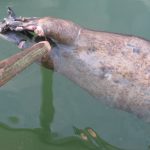As temperatures in the Arctic rise and sea ice disappears, Utqiaġvik is experiencing severe erosion. Buildings and critical infrastructure are threatened in the whaling community formerly known as Barrow. These include a utilidor, a three-mile-long artery that handles water, sewer, telephone, fiber-optic cable, and electricity. If the utilidor is disabled or destroyed, Utqiaġvik’s residents would face an immediate public health crisis.
“You’d have 4,000 people who all of a sudden couldn’t wash their hands,” said longtime Utqiaġvik resident and archeologist Anne Jensen.
To boost Utqiaġvik’s ability to manage climate change threats, Alaska Sea Grant is supporting research by the University of Alaska in partnership with the North Slope Borough and local citizen scientists. Much of the work is being done on the beach and along a gravel berm —a man-made structure that washes away and gets rebuilt with each major storm—that separates the Arctic Ocean and the town.
Citizens are being trained to take shoreline measurements and collect other data to document what’s happening along their coast. In addition, an Argus video camera will capture images to document wave conditions and water levels. Data collected will be used to calibrate and validate the storm surge, coastal flooding and coastal erosion forecasting system.
Researchers hope to improve forecasting so that in the event of a large storm, more accurate information can be provided to the North Slope Borough Risk Management Office and emergency responders can better respond to control erosion and flooding.
Read more about the project on the Alaska Sea Grant blog.







